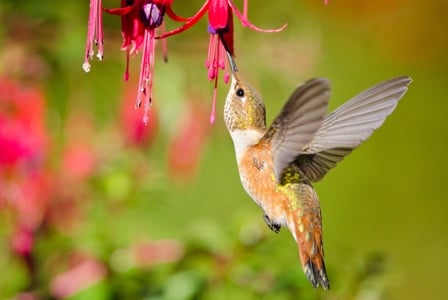
Learn about the rufous hummingbird – a feisty bird thats flitting back to BC in time for spring.
Spring is in the air, and the warmer weather is prompting rufous hummingbirds to flit back to BC. While most backyard birds are par for the course, the iridescent blur of a nectar-seeking hummingbird is cause for excitement. This Wildlife Wednesday, learn about the feisty rufous hummingbird.
Habitat
A migratory species, rufous hummingbirds range further north than any of their hummingbird relatives. They can be spotted in flower-filled forests, meadows, parks, and gardens across Canada and the US.
Trivia
- Although tiny and dainty in appearance, rufous hummingbirds are quite feisty. They will aggressively defend their territories, even against chipmunks and other larger species.
- Like all hummingbirds, the rufous variety loves to snack on the nectar of colourful flowers. Some of their favourite blooms include columbines, Indian paintbrush, fireweed, lilies, larkspurs, currants, and heaths.
- Although nectar is hummingbirds’ most well-known source of food, these winged wonders also chow down on small insects and tree sap.
- Male rufous hummingbirds sport neon patches of orange-red on their necks, while females are typically greener.
- Hummingbirds flap their wings in a figure-eight pattern rather than up and down, allowing them to hover in place.
- They can also flap their wings 80 times per second, which makes me feel very lazy.
- The average hummingbird heart rate is 1,260 beats per minute. By comparison, our wimpy human hearts average 80 beats per minute.
Why are they threatened?
Rufous hummingbirds wander far and wide, so they’re not currently at risk of extinction. Nevertheless, their declining numbers have led the IUCN to label them as a Least Concern species.
Although scientists have yet to pin down the exact reasons for this dip, rufous hummingbirds may be affected by habitat loss across their migratory range. On the other hand, artificial feeders offer a ready source of food for hummingbirds and invite these beautiful birds into our backyards. Keep in mind, however, that feeders can increase the birds’ chances of colliding with windows and encountering cats.

